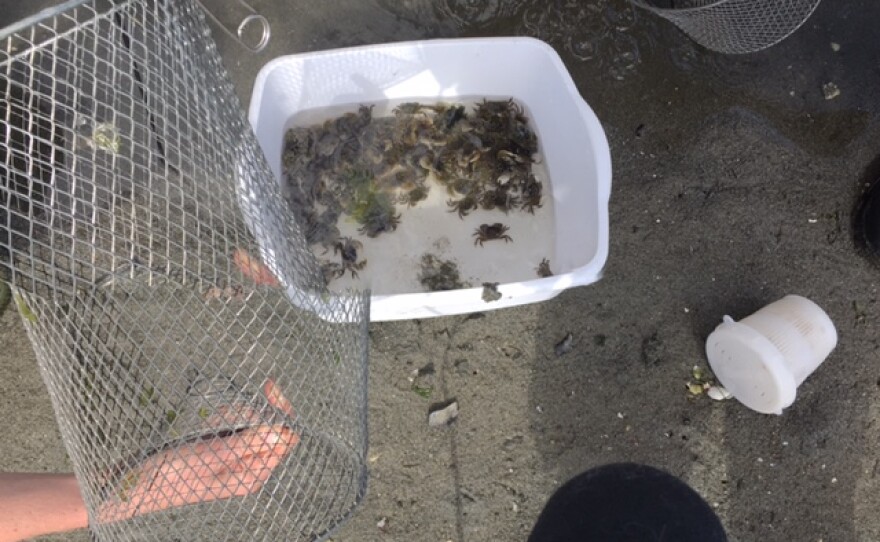This week, scientists are scouring shoreline habitat near Westcott Bay on San Juan Island, hunting for green crabs. The Washington Sea Grant Crab Team, with help from the state Department of Fish and Wildlife, will set dozens of traps in an effort to learn more about the population of the invasive species.
Last month, one was found there for the first time, confirming that European green crabs have entered Washington’s inland waters.

The rapid response is part of an ongoing monitoring effort that’s powered mostly by volunteers. The Grant Crab Team has about two dozen sites around Puget Sound and the San Juans that they’re monitoring closely. In fact it was a team of volunteers who found the first crab at Westcott Bay.
At Point Heyer on Vashon Island, marine ecologist Jeff Adams pulls a wire mesh trap from the sand. The salt marsh and shallow lagoon here is another one of the monitoring sites, considered prime habitat for green crabs. Adams says this trap isn’t very full.
“But you can see there’s still maybe a dozen or more crabs in here, ” he says as he taps the sides of the trap to force them into a rubber basin where they can be counted and cataloged.
Thankfully, he says these are all native hairy shore crabs.

“And that is also what we expect to be finding in the areas that are most suitable to the European green crab. So, it kind of reinforces that this is probably a suitable habitat, should the larva be able to come in to here,” he said.
The Sea Grant team suspects green crab larva washed into Washington’s inland waters from British Columbia’s Sooke Inlet, where a thriving population of green crab has been established since at least 2012. That’s the best explanation for how the invasive species got to San Juan Island.
And Adams says once they take hold, green crabs tend to take over, because they eat almost everything, from sensitive eel grass to worms, clams, snails and other crabs.
“And then that could affect for example juvenile salmon, adult salmon, orcas. So there are food web effects everywhere from the worms that people may not give much attention to up to something like salmon and orcas that we're far more concerned about,“ he said.
On the East Coast, they’ve had a heavy impact on the soft shell clam industry and have seriously damaged eel grass beds. That’s why the crab team will be setting their traps all over the beaches near Westcott Bay, to get a better idea of how much of a population has established there.
Crab team program coordinator Emily Grason says she’s hopeful they’ve detected the problem early.
“The fact that our volunteers have been working at that exact site all summer long since April and this is the first time they have found a crab suggests that it’s not overrun with green crabs yet,” she said. She says that crab has likely been there for two or three years.
Any green crabs the Sea Grant team finds will be frozen and cataloged to determine what next steps they should take. Once scientists know more about the extent of the population, they’ll design a response. Grason says volunteers will have a big role to play in any case.
“We have established a really widespread network of people who are looking very closely for this crab. And I have a lot of confidence that if crabs are at those site, they’ll show up,” she said. “This increased awareness will get more people looking and our vigilance is our best defense.”
The Sea Grant Crab Team is hosting a public presentation at Friday Harbor Labs Tuesday evening to answer all kinds of questions and train more people on how to identify the invasive green crab and their molts. They say the contributions of all their volunteers have great value because of the baseline data they are generating on the species and habitat conditions throughout Puget Sound and the San Juans.












